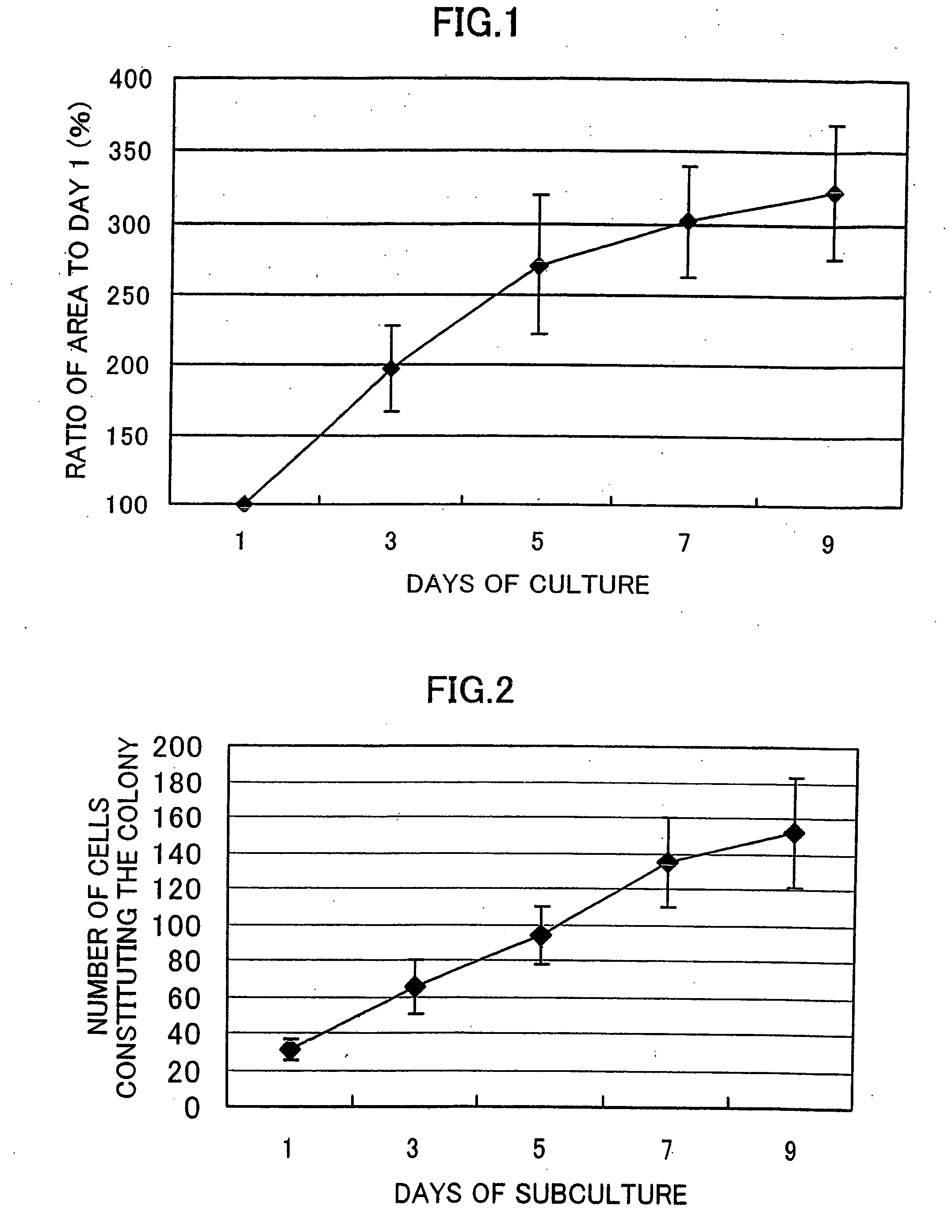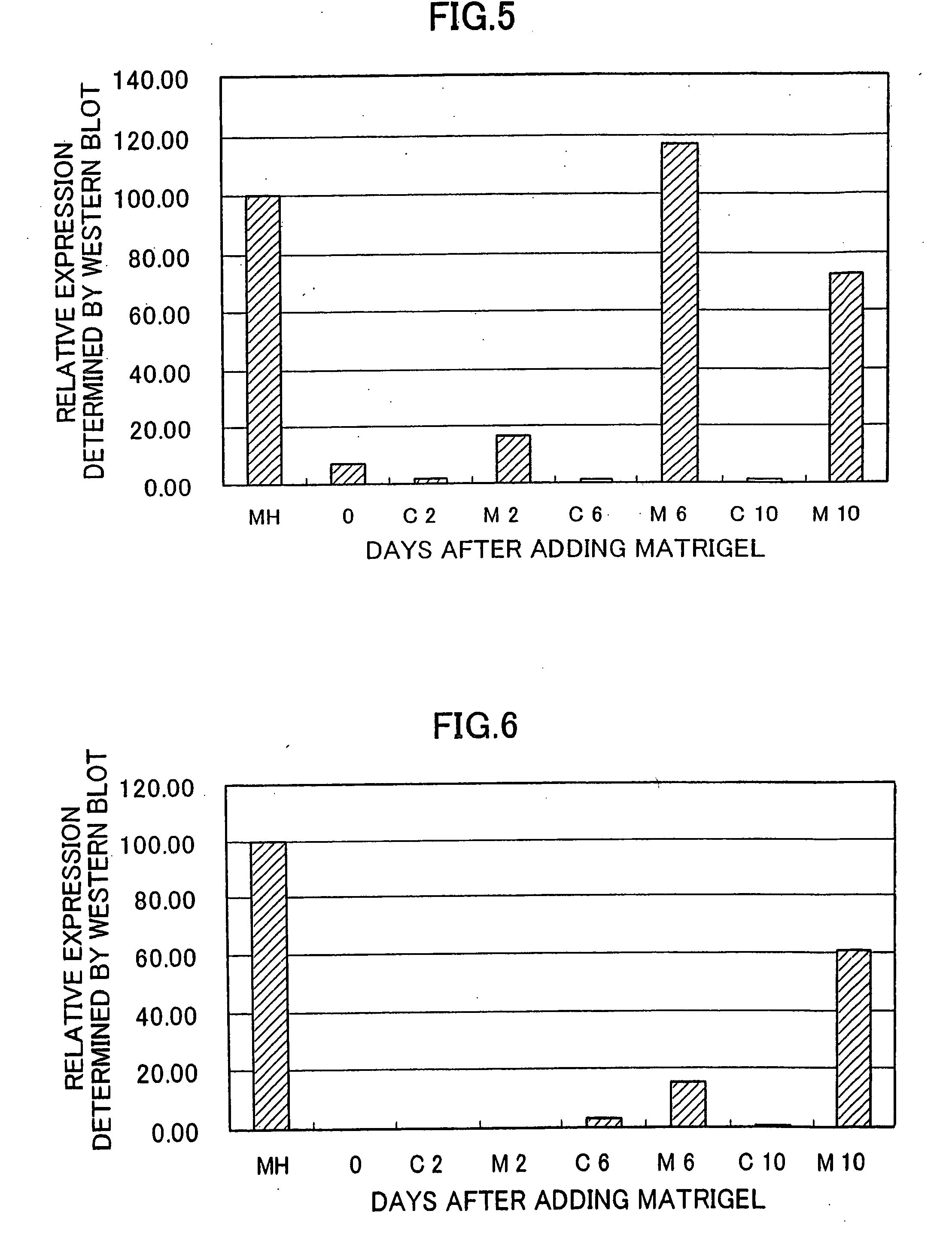Small hepatocyte-rich colonies, process for preparing the colonies, process for maturating the colonies into liver tissue and method of estimating effects of drug by using matured small hepatocyte-rich colonies
a technology of hepatocytes and small hepatocytes, applied in the field of cell colonies, can solve the problems of reducing the therapeutic effect of these drugs on each other, not being able to form an organ having a sufficient size, and further weakened the pharmacological effect of warfarin
- Summary
- Abstract
- Description
- Claims
- Application Information
AI Technical Summary
Benefits of technology
Problems solved by technology
Method used
Image
Examples
example 1
Method of Isolating Small Hepatocytes
(1) Isolation of Small Hepatocytes from Liver Tissue
[0087] The liver of each mature rat (10 to 15 weeks old) was perfused through the portal vein according to Seglen's method using Hanks' solution free of Ca and Mg supplemented with 0.2 mM EGTA. After the perfusion with 40 ml / min of Hanks' solution for 4 minutes, the rat was perfused with 20 ml / min of Hanks' solution containing 0.02% of collagenase (Yakult) for 10 minutes. The hepatocytes were collect into a beaker from the digested liver according to the conventional method. The cell suspension was filtered through a 70 82 m mesh filter and then centrifuged at 50×g for 1 minute. The supernatant was taken and centrifuged at 50×g for 5 minutes. The precipitated cells were washed with a culture medium (Leibovitz L-15, 10% fetal calf serum, 10−7 M dexamethasone, 0.5 μg / ml insulin and an antibiotic) and then centrifuged at 50×g for 5 minutes. The similar process as above was repeated once, and the...
example 2
Isolation of Small Hepatocyte-rich Colonies
[0089] When the small hepatocyte colonies had become to be clearly observed about 1 week after the culture of the small hepatocytes isolated as described in Example 1, the small hepatocyte colonies were prepared as described below.
[0090] The cells were washed twice with sterilized phosphate buffer. Then the cells were immersed in a phosphate buffer containing 0.02% EDTA. After leaving them to stand for several minutes, the phosphate buffer was aspirated. 1 ml of enzyme-free cell detaching solution (Cell dissociation solution, Sigma) was added into the culture dish and they were left to stand at 37° C. for 15 minutes. Then the cells were gently pipetted so as not to damage the cells to carefully detach the cells from the culture dishes. The cells were collected in centrifugation tubes and then centrifuged at 50×g for 5 minutes. The supernatant was aspirated, then washed with the culture medium containing 10% of serum and then centrifuged a...
example 3
Induction of Small Hepatocytes into Liver Tissue (1)
[0092] 1.5-3.0×103 colonies / dish of the small hepatocyte-containing colonies obtained in Example 2 were placed on a culture dish (diameter: 35 mm).
[0093] They were cultured in a 5% carbon dioxide incubator at 37° C. About 1 week after the successive subculture, the colonies of the small hepatocytes produced colonies which have on average 3 times as large area as that on the first day and the number of the cells was increased to 5 times as large (FIGS. 1 and 2).
[0094] When the area of the colonies at the bottom of the culture container had become about 20% to about 30% (about 20% to about 30% confluent) about 2 weeks after the successive subculture, 500 μg / ml of the extracellular matrix (product name: Matrigel) (composed of the basement membrane and containing 60% of laminin, 15% of type IV collagen, proteoglycan, entactin, etc.) extracted from Engelbreth-Holm-Swarm sarcoma (EHS sarcoma) was added to the culture medium.
[0095] Af...
PUM
 Login to View More
Login to View More Abstract
Description
Claims
Application Information
 Login to View More
Login to View More - R&D
- Intellectual Property
- Life Sciences
- Materials
- Tech Scout
- Unparalleled Data Quality
- Higher Quality Content
- 60% Fewer Hallucinations
Browse by: Latest US Patents, China's latest patents, Technical Efficacy Thesaurus, Application Domain, Technology Topic, Popular Technical Reports.
© 2025 PatSnap. All rights reserved.Legal|Privacy policy|Modern Slavery Act Transparency Statement|Sitemap|About US| Contact US: help@patsnap.com



